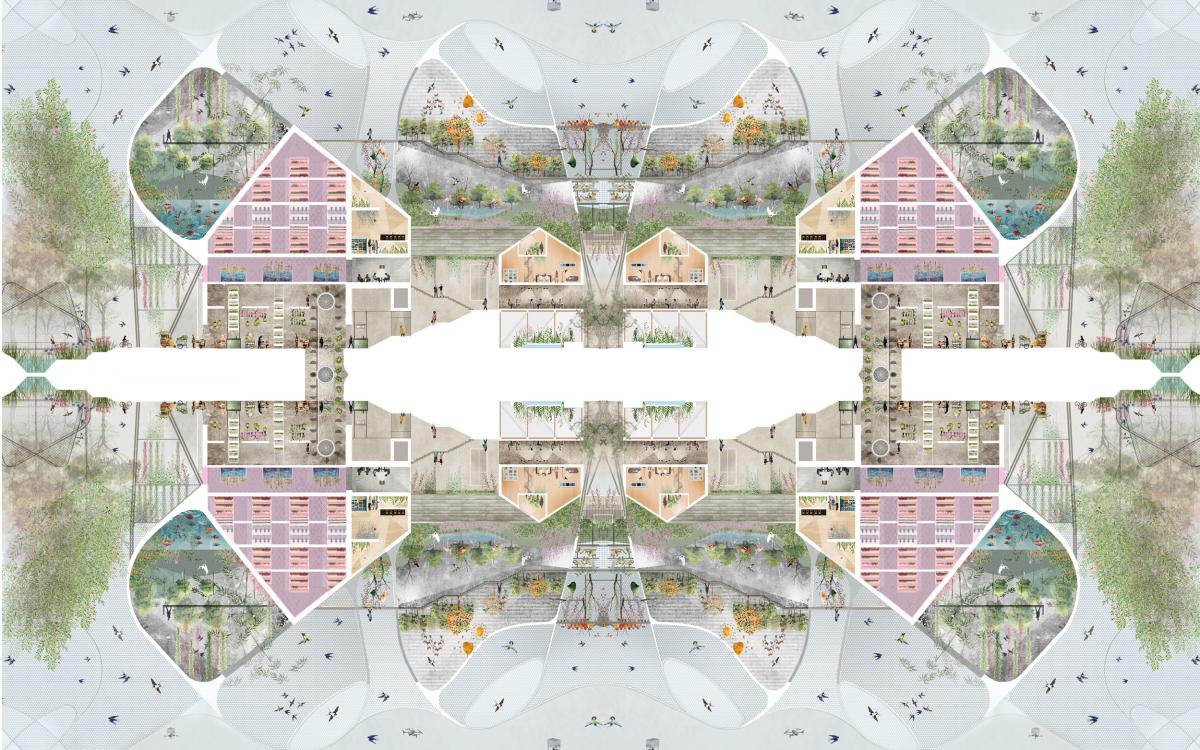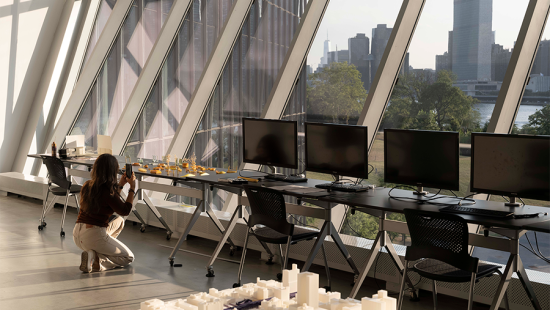The Ethics of Building
Architecture alum Sarosh Anklesaria discusses his work and his approach to practice that (re)build connections between buildings and the material and political realities of their sites.
In a conversation on the role of the architect and architecture's role in shaping the world, Ji Yang (M. Arch. '21) of Citizen Architect discusses ethics, education, and agency with architect, educator, and alum Sarosh Anklesaria (M.Arch.'10), professor of architecture at Carnegie Mellon University. Anklesaria's work locates architectural agency and worldmaking across a range of scales, temporalities, and geographies. His recent projects have been supported by The Richard Rogers Fellowship, The Art Omi Residency, and the Taliesin Fellowship. In addition to teaching, Anklesaria runs his own eponymous design practice, Sarosh Anklesaria Design Studio. Previously, he cofounded Anthill Design in Ahmedabad, and has worked for Diller Scofidio + Renfro in New York City, Herzog & de Meuron in Basel, and B.V. Doshi in Ahmedabad.
Anklesaria and Yang's discussion is one of several included in Citizen Architect's self-produced podcast and self-published zine initiated by a student-run think tank creating a platform to "bridge the gap between architecture, culture, and society." Citizen Architect includes Yang, Jeniffer Carmona (M. Arch. '21), Jully Chen (M. Arch. '21), Riana Tan (M. Arch. '21), and George Tsourunakis (M. Arch. '21). This abridged conversation has been adapted from the original Q&A, Ethics of Building, conducted by Ji Yang and published by Citizen Architect in fall 2020. The full podcast is now available on Apple Podcasts and Spotify.

The Urban Symbiome is Anklesaria's recent proposed vision for a future based on an ethic of kinship, degrowth, and circular thinking, foregrounding local cultures of food and combining decolonization with ecological remediation. Located in the urban-periurban context of London, it can also serve as a template for "cooking new worlds" across various geographies. The Urban Symbiome will be featured in Expansions, a publication by La Biennale di Venezia in conjunction with the 17th International Architecture Exhibition, How Will We Live Together? image / Sarosh Anklesaria in collaboration with Priyanka Sheth
JY: You trained as an architect in both India and the U.S. and continue to practice in both countries as well as others. How have your early experiences shaped you as an architect today?
SA: I grew up in India in the 80s and 90s, and as a young architect, our entire education was steeped in the doctrine of critical regionalism. At that time, we were taught to somehow understand the kind of spatial qualities embedded in specific locations of our different regions. In hindsight, what it did for me was to somehow heavily fetishize notions of place. While super important in its critiques of globalization, I think what often happens is that architects somehow remove themselves from asking more explicitly political questions — how architecture is complicit with neoliberal capitalism and extractive ecologies of material and labor. Because of this romanticization of place, I've become increasingly critical of critical regionalism. Instead, I understand architecture to be much more of a political act. Architects must enact what I call 'agency' to really engage questions of practice embedded in politics, globalization, and ecology.
 Anklesaria and Riyaz Tayyibji, Studio for an Artist (2005), Ahmedabad. Left: Not necessarily a desirable condition, the construction site often becomes a playground for the children of daily wage laborers; upper right: the building uses excavation (cut and fill) as a primary medium for organizing the building and its relationship to the site — a bioclimatic strategy that also offers multiple ways to traverse the site. photos / Anklesaria and Tayyibji. Lower right: the completed project seldom reveals the tribulations of labor that go into its building. photo / Deepshikha Jain
Anklesaria and Riyaz Tayyibji, Studio for an Artist (2005), Ahmedabad. Left: Not necessarily a desirable condition, the construction site often becomes a playground for the children of daily wage laborers; upper right: the building uses excavation (cut and fill) as a primary medium for organizing the building and its relationship to the site — a bioclimatic strategy that also offers multiple ways to traverse the site. photos / Anklesaria and Tayyibji. Lower right: the completed project seldom reveals the tribulations of labor that go into its building. photo / Deepshikha Jain
JY: Could you elaborate on some instances in your career when you were questioning the ethics, politics, and methods that pertain to globalization or ecology?
SA: One of the early projects I worked on, perhaps the very first one, was a project with a $20,000 budget for an artist's studio — an amount (not adjusted for inflation) that was only possible because of the low cost of labor. I was maybe 23 or 24 years old. I would go to the site every day, and I was both completely prepared and utterly not prepared for what I was confronted with. I dealt with the labor on site, which is a very common occurrence and somehow very familiar. Yet, I immediately felt a certain kind of obligation and responsibility for the people building my projects — the laborers that were building this studio for us. For example, some underpaid laborers were also nursing mothers with newborn babies, and children were running around barefoot at the site. The workers lived in self-built hay shacks, with stagnant water and the risk of malaria. These are the sorts of things, their immediacy, that makes one feel in a sense very unprepared and vulnerable because they are not a part of architectural school, which still belongs to the ethos of Bauhaus education.
We were taught in abstract terms, which is both necessary but also problematic. Abstraction brings with it a certain disconnection. I cherish everything I was taught in architecture school, but at the same time, I think we have to understand the disconnections. When we practice, I think it's important that we rebuild these connections, rebuild what architecture means for the people, for the environment, for labor, and for the ecologies that are enmeshed and embedded through our projects.
I was working for Herzog and de Meuron on the Kolkata Museum of Modern art, which was a very large project. I remember during the initial research the thought was to build this entire building out of brick. This is an enormous building and brick is a local material in Kolkata and a lot of old Bengali architecture is famous for its brickwork, for example, the Brick temples of Bengal. This goes back to critical regionalism where there's a certain kind of romanticism about brick and Bengali architecture. People say things like, "oh, you're building in Bengal you must want to build out of brick." But the ecologies of brick are actually very detrimental. Brick uses topsoil. Topsoil is used in agriculture. The bricks are often built from agricultural land that is leased out by vulnerable farmers. They lease it out to brick companies, and once they get their land back, you know, there's no topsoil, so they cannot use the land for farming anymore. And so in India, we see farmer suicides, and we only exacerbate the problem. While we were still doing material research on this project, we realized these disconnections. Also, local brick from different small kilns will vary in size. So we decided to use concrete masonry units. More generally, I have found that working in regional contexts makes what we expect to be a neat and calculable project, designed with precision by prominent architects, actually very messy once you start really tracing the material ecologies of things.
"Abstraction brings with it a certain disconnection...When we practice, I think it's important that we rebuild these connections, rebuild what architecture means for the people, for the environment, for labor and for the ecologies that are enmeshed and embedded through our projects." – Sarosh Anklesaria
JY: Can you say a bit more about the importance of moving from abstraction in design to the reality/materiality of building?
SA: Architecture is enmeshed in questions of ecological thinking, and I think the more you sort of unpack this, the more you understand how we are embedded in the material world. Materiality bridges, moves us away from abstraction, into the realm of the real, into the realm of labor, into the realm of life — into contact with all the processes by which materials actually move from what is called cradle to grave. Our adjacent disciplines, fashion, for example, are reengineering material production. There are very real, very strong movements for cradle-to-cradle material cycles, and I think increasingly in architecture, we are aware of waste in building construction. Practices like upcycling fall within a circular, cradle-to-cradle model — and so again, we need to keep looking closely at the material production of things and recalibrate for real material conditions in the world.

JY: What is a citizen architect to you?
SA: Broadly speaking, a citizen architect is someone who acknowledges that architecture is in and of this world. A citizen architect must problematize and question the discipline's entanglements with things that are complex and difficult to answer — relationships between form and issues of ecology, labor, and politics. These are factors that actually change how things are built, how things look and feel. The pressing question of our time is the global economy that is premised on the creation of excess, through extraction, exploitation, and surplus profit, and whether we can create the mode of practice we absolutely need to critique and counter this model. The future of practice then depends on finding new models by which we can fully acknowledge the current socio-ecological crisis and respond. I think a citizen architect is someone who actually considers society — the ethics of care and maintenance, and in doing so conjoins the social with the ecological, and even planetary, questions that arise in designing an ethics of practice.







